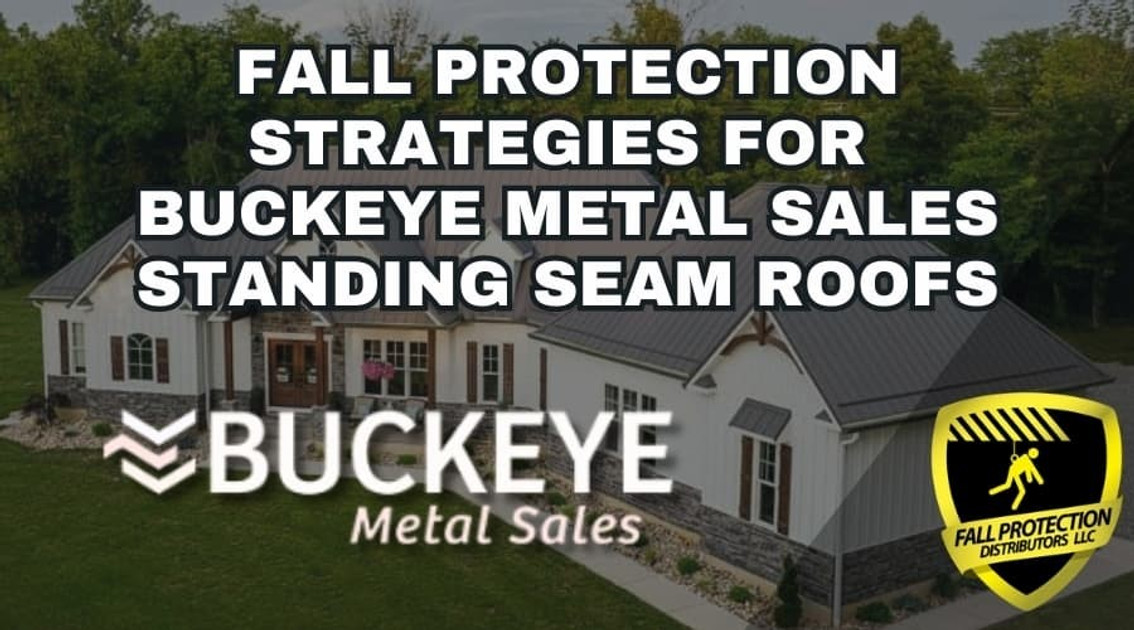Fall Protection Strategies For Buckeye Metal Sales Roofs
Posted by Howie Scarboro - CEO Fall Protection Distributors, LLC on Sep 19th 2025
See the Roof Anchor Compatibility Chart for Buckeye Metal Sales Standing Seam Panels.

Who Is Buckeye Metal Sales?
Buckeye Metal Sales, often referred to as Buckeye Metal Roofing, has been serving south-central Ohio since 2004 as a family-owned and operated business.
Tim Miller founded Buckeye after gaining more than 40 years of experience in metal construction, building the company on service, timeliness, and hands-on expertise. Many employees brought their own metal building backgrounds, adding practical insight that helps them understand the challenges and needs of contractors and homeowners.
Headquartered in Frankfort, Ohio, with a showroom and office open to the public, Buckeye Metal Sales supplies premium metal roofing, siding, and wall systems across the region, including the greater Columbus area. Their diverse product lineup includes standing seam roofing, board and batten siding, shingles, corrugated accents, overhead doors, and complete building packages such as pole barn kits or barn-to-home combinations. By providing such a wide range of solutions, Buckeye has become a trusted one-stop shop for residential, commercial, and agricultural projects.
The company sets itself apart by delivering short lead times, dependable service, and personalized support. Customers can even design and preview projects using Buckeye's Metal Roof and Siding Visualizer, a tool that showcases their commitment to innovation and convenience. With BBB accreditation since 2020, Buckeye continues to build on its reputation for reliability, integrity, and exceptional service. For over 20 years, this approach has made Buckeye Metal Sales a leading name in Ohio's metal roofing and siding industry.

Why Are Compatible Fall Protection Anchors So Critical For Standing Seam Roofs?
Buckeye Metal Sales' engineers design its Standing seam metal roofs to deliver long-term performance, energy efficiency, and superior weather resistance, but only if their seams remain intact.
Every rib in the system plays a critical role in keeping water out and maintaining wind resistance. When contractors use anchors that require drilling or puncturing, they compromise this watertight design. Even one hole in a seam can void a manufacturer's warranty, weaken the roof's performance, and create pathways for costly leaks or corrosion.
Beyond protecting the roof, compatible anchors are vital for keeping workers safe. OSHA requires 100% fall protection when working at heights, and standing seam surfaces can be slick, steep, or exposed to high winds. Standard anchors that don't match the seam geometry or panel gauge can slip or deform under load, putting crews at risk. Non-penetrating systems designed specifically for standing seam panels clamp securely to the rib without drilling, creating strong, OSHA-compliant tie-off points that protect both the roof and the worker.
For steeper roof slopes, ridge-mounted systems such as the Ridge Pro Steep Assist provide a safe alternative. Installed over the ridge using a lightweight extension pole, the Ridge Pro enables workers to tie off before stepping onto the roof, ensuring a 100 percent tie-off from the ladder to the ridge and back again.
Choosing compatible fall protection is about more than compliance—it's about protecting lives and preserving investments. On Buckeye Metal Sales standing seam roofs, using the proper anchors is the only way to maintain system integrity while keeping workers secure.
1.5 Inch Nailstrip Panel

The 1.5-inch nailstrip panel from Buckeye Metal Sales combines clean aesthetics with straightforward installation, making it a practical choice for both residential and commercial projects.
This standing seam system conceals all fasteners for a seamless finish, while providing the strength necessary to withstand Ohio's changing weather conditions. Contractors appreciate its nailstrip fastening method, which eliminates clips, reduces material costs, and speeds up installation without sacrificing durability. See the Roof Anchor Compatibility Chart for Buckeye Metal Sales 1.5 Inch Nailstrip Standing Seam Panels.
This profile features a 1.5-inch seam height with standard 15-inch coverage. Panels are rolled on-site for exact lengths, ensuring precision for unique roof designs. Available in both 26-gauge and 24-gauge steel, the panel offers flexibility depending on project needs. The 26-gauge version is suitable for lighter residential applications. The heavier 24-gauge option delivers better long-term performance and provides greater resistance against high winds.
Each panel utilizes AZ50 Galvalume steel as the base substrate, coated with AkzoNobel CERAM-A-STAR 1050 Cool Chemistry paint for enhanced energy efficiency and long-lasting color. The paint system reflects solar heat to help keep interiors cooler while maintaining fade resistance. Customers can select from Buckeye's selection of finishes, including smooth or textured crinkle coatings for added style and visual appeal.
The nailstrip design makes installation more efficient than clip-based or mechanically seamed panels. Contractors secure fasteners through the flange, then snap the adjacent panel over the seam, concealing fasteners for a watertight look. The system requires a minimum slope of 3:12 to ensure proper drainage. It is suitable for homes, barns, garages, and small commercial projects. With proper installation, these panels can last 40 to 60 years with minimal maintenance.
Fall Protection for 1.5 Inch Nailstrip Panel
For 24-gauge steel versions, the panel is fully compatible with the complete SSRA system.
The SSRA1 Seam Anchor clamps directly to the seam without drilling, providing a strong OSHA-compliant tie-off point that preserves the roof's integrity. When mounted with the SSRA2 Adjustable Roof Jack Adapters, crews can install 10-foot walkboards for stable footing across large areas of the roof. The SSRA3 Anchor Plate can be added on top of the SSRA1 anchors to create secure tie-off points for temporary horizontal lifeline systems, giving multiple workers safe mobility across long spans.
Avoid seam clamping on lighter 26-gauge steel panels, as the material cannot support the anchor safely. Instead, the Ridge Pro Steep Assist Anchor provides the most reliable solution. Placed over the ridge with a 16-foot extension pole, the Ridge Pro allows workers to tie off before stepping onto the roof. It supports slopes between 6:12 and 12:12, ensuring 100 percent tie-off from the ladder to the ridge and back down again. This system prevents seam damage while providing crews with the security they need to work confidently.
2 Inch Mechanical Panel

The 2-inch mechanical panel from Buckeye Metal Sales delivers strength, durability, and watertight performance for demanding commercial and industrial projects.
With its taller seam height and mechanically crimped design, this panel provides superior resistance against wind, water intrusion, and long-term structural stress. Unlike nailstrip or snaplock systems, the 2-inch mechanical seam excels on low-slope roofs and in high-pressure environments. See the Roof Anchor Compatibility Chart for Buckeye Metal Sales 2 Inch Mechanical Standing Seam Panels.
This profile features a 2-inch rib height and 14-inch standard coverage; however, variations between 12 and 16 inches may be available, depending on project requirements. Panels are formed on-site in custom lengths, ensuring precise fits for large commercial spans.
Available in both 24-gauge and 26-gauge steel, the panel offers flexibility tailored to meet various structural needs. The heavier 24-gauge option provides maximum strength and performance in high-wind or hurricane-prone areas. At the same time, the 26-gauge version is suitable for lighter applications but requires careful consideration of fall protection measures.
The panels are manufactured from AZ50 Galvalume-coated steel, offering excellent corrosion resistance, and finished with AkzoNobel CERAM-A-STAR 1050 paint. This coating system enhances energy efficiency by reflecting solar heat, thereby reducing cooling costs for large buildings. With concealed clips and mechanical seaming, the system allows for thermal expansion without compromising the roof's weather-tightness.
Fall Protection for 2 Inch Mechanical Panel
The 24-gauge steel version of this panel is fully compatible with the complete SSRA fall protection system.
Contractors can securely mount the SSRA1 Seam Anchor directly to the seam, creating a strong, non-penetrating tie-off point that does not damage the roof. The SSRA2 Adjustable Roof Jack Adapters mount on top of the SSRA1 Anchors, providing crews with the ability to install sturdy 10-foot walkboards for stable footing while working across long stretches of roof. The SSRA3 Anchor Plate offers additional versatility, allowing temporary horizontal lifeline systems to be mounted for multiple workers to move safely across large commercial spans.
Do not use seam clamping on 26-gauge panels because the lighter material cannot handle the stress safely. In these cases, the Ridge Pro Steep Assist is the most effective solution. Installed over the ridge with a 16-foot extension pole, the Ridge Pro allows workers to tie off before stepping onto the roof. This anchor supports slopes ranging from 6:12 to 12:12 and ensures a 100% tie-off from the ladder to the ridge and back. By avoiding seam deformation, it protects both the worker and the panel integrity.
Metal Roof Anchor Panel Compatibility For Buckeye Metal Sales
| 1.5 Inch Nailstrip Panel 24 ga. only |
2 Inch Mechanical Panel 24 ga. only |
|
|---|---|---|
SSRA 1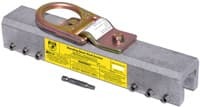 |
NO | NO |
SSRA1 Nylon Tip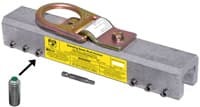 |
YES | YES |
SSRA2 Roof Jack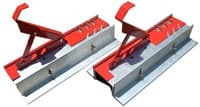 |
YES | YES |
SSRA3 Anchor Plate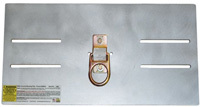 |
YES | YES |
The Ridge Pro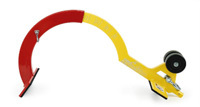 |
YES | YES |
Contact Us For More Information
For further details on roofing solutions and fall protection systems, please get in touch with us at 863-703-4522 or www.StandingSeamRoofAnchor.com. Let's work together to make your roofing projects safe, beautiful, and built to last. For more safety tips, refer to OSHA's 48-page Fall Protection Manual. Once you have determined the most suitable anchors for your roof system, download our free Anchor Inspection Form.
Safety Tips For Standing Seam Roofs
Promote a Culture of Safety
Safety can become part of the daily routine, not just words in a rulebook. Crews who feel heard and respected look out for one another, spot hazards early, and speak up before minor issues turn into accidents. A culture of safety builds trust on the ground and confidence on the roof.
Use Specialized Anchor Systems for Standing Seam Roofs
Standing seam panels require anchors explicitly made for them—not generic options that risk damaging seams or voiding warranties. Drive a screw through the seam, and you've voided the warranty and invited leaks. Seam-mounted anchors clamp securely without a single penetration, creating reliable tie-off points that adhere to OSHA standards while protecting the integrity of the roof system. Avoid using seam anchors that require heavy torque to lock in place or require that the anchors be mounted over top of the hidden clips. It is nearly impossible to know the actual locations of hidden clips on existing standing seam roofs.
Encourage the Use of Trauma Straps
Stopping the fall is only the first step. Without trauma straps, suspension can cut circulation in minutes. With them, a worker can shift weight, ease pressure, and keep blood flowing until help arrives. They're small, cheap, and one of the most effective tools you can add to a harness.
Install Permanent Roof Anchor Systems
Some roofs experience constant traffic—such as HVAC checks, solar installations, and inspections. Permanent anchors solve the problem once. When properly installed, they create tie-off points that never go away. Workers spend less time rigging and installing temporary setups, and more time getting tasks completed safely.
Ensure Proper Footwear for Stability
The proper boots can make or break a workday. Aggressive tread, solid ankle support, and slip resistance keep workers steady on slick or sloped panels. Good footwear also helps crews stay sharp and balanced, rather than feeling drained by the end of the day.
Develop OSHA-Compliant Safety Plans
Every job starts with a plan. Please write it down, review it, and make sure the crew understands it. A solid safety plan maps hazards, assigns responsibilities, and outlines the procedures to follow in the event of an incident. Good safety plans require practice and communicationto keep teams aligned, efficient, and ready for surprises.
Set Up Protective Guardrail Barriers for Work Zones
Guardrails save lives quietly around skylights, roof edges, or hatches without needing worker input. The barrier is visual, physical, and constant, which means one less hazard for crews to worry about on a busy site.
Equip Workers with High-Quality Safety Gear
Safety gear is only as good as its condition and fit. A harness that hugs comfortably, lanyards that pass inspection, and SRLs rated for the task give workers confidence. Routine checks matter—gear that feels trustworthy keeps focus on the job, not the tie-off. OSHA now mandates that all equipment MUST fit the workers properly.
Consult Experts for Curved Metal Panels
Curved panels require additional fall protection expertise to determine the best plan of action. That's why a fall protection expert is critical before work begins. They can analyze the system and recommend anchors or lifelines that won't compromise the roof or the crew.
Prioritize Ladder Safety Training
Most accidents don't start on the roof—they start on the ladder. Teaching crews the 4-to-1 setup rule, emphasizing three points of contact, and securing ladders where necessary, prevents the majority of mishaps. A quick refresher before every project keeps safe climbing top of mind.
Disclaimer
The views, recommendations, and information presented in this blog are solely those of the author and do not necessarily reflect the opinions or positions of the featured panel manufacturer, its brands, subsidiaries, or parent companies. Customers are strongly encouraged to contact the roof panel manufacturer directly for inquiries regarding fall protection compatibility with their products and to address any potential warranty issues that may arise after installing our products.

